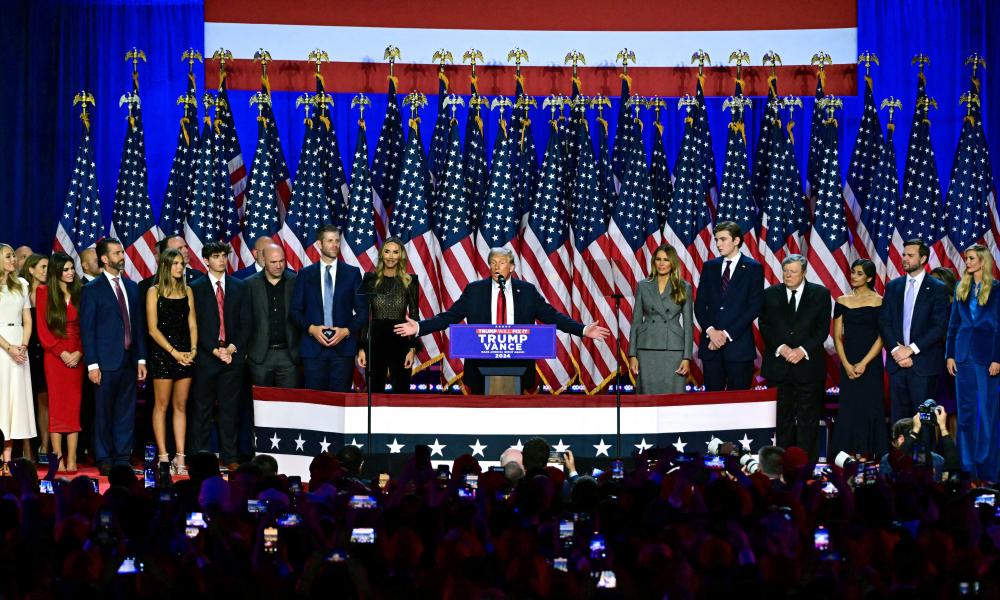The recent presidential election witnessed a high-stakes showdown between Donald Trump, the Republican nominee and former president, and Kamala Harris, the Democratic vice-presidential incumbent. As results trickled in, Trump secured pivotal victories in crucial swing states, such as North Carolina, Georgia, and Pennsylvania, positioning himself favorably for a return to the White House. With the atmosphere electrifying at Trump’s election watch party in Palm Beach, exhilarated supporters celebrated his apparent victory as Fox News declared Pennsylvania for Trump, eliciting cheers and chants of national pride. As the crowd awaited Trump’s appearance, the mood was one of triumph and impending change, suggesting a potential shift in the political landscape amid concerns over the integrity of democracy.
When Trump eventually addressed his supporters, he characterized his campaign as an unprecedented and powerful movement, claiming a profound mandate and highlighting his commitment to healing and revitalizing the nation. Surrounded by family and supporters, including his vice-presidential pick, JD Vance, he declared his intentions to strengthen borders, restore safety, and promote economic growth. The former president’s narrative echoed themes of loyalty and resilience, as he referred to past challenges, including assassination attempts against him, framing his return as a redemptive and transformative moment for America. His rhetoric continued to resonate with a base eager for a return to his leadership style and policies.
In stark contrast, the mood at Harris’s watch party at Howard University was subdued as hopes dwindled for her potential presidency, which would have marked a historic moment for representation. Democrats had to grapple with the reality of losing significant races, including the Senate, deepening the sense of despair among party supporters. Richmond’s message focused on perseverance and the ongoing struggle for every vote to be counted, embodying the uncertainty surrounding the election. The emotional turmoil among attendees reflected a sense of déjà vu reminiscent of previous elections, signifying deep divisions in the electorate and the challenging road ahead for the Democrats.
The 2024 election established a clear divide within both chambers of Congress, with Republicans re-taking the Senate amid critical losses for Democrats. The outcome positioned Trump favorably for further consolidation of power, especially with judicial appointments that could impact crucial social and economic issues. While minor victories were secured by Democratic candidates like Angela Alsobrooks in Maryland, the overall results indicated a more profound shift toward Republican control. The House of Representatives remained contested, reflecting the ongoing struggle for balance in governance amidst contentious party ideologies and priorities.
Issues surrounding abortion rights became particularly contentious during this election, reflecting a broader societal debate on women’s reproductive rights within the Democratic base. Despite energized campaigns advocating for legal protections, results were mixed, with many Democratic-led initiatives falling short. This indicated both challenges and backlash stemming from past decisions by the Supreme Court, led by Trump-appointed justices. Voter sentiment demonstrated a significant gender gap, with differing priorities reflected in the polls as voters weighed economic concerns and threats to democracy highly. Thus, the election unfolded amid heightened tensions concerning civil rights and economic stability.
As Trump’s triumph signaled a shift toward rightwing populism, it raised apprehensions internationally regarding the implications for global politics and support for Ukraine amidst ongoing conflicts. His “America First” ethos appealed to many, yet stoked fears of polarized governance back home, where Trump’s narratives cast opponents as existential threats. By framing his agenda around national security and purity, Trump’s messaging played into prevailing fears that would continue to polarize the American populace. In this turbulent political climate, his firm commitment to “Promises made, promises kept” underscored a resilience against opposition, heralding a new chapter in American politics fraught with both challenges and opportunities.

